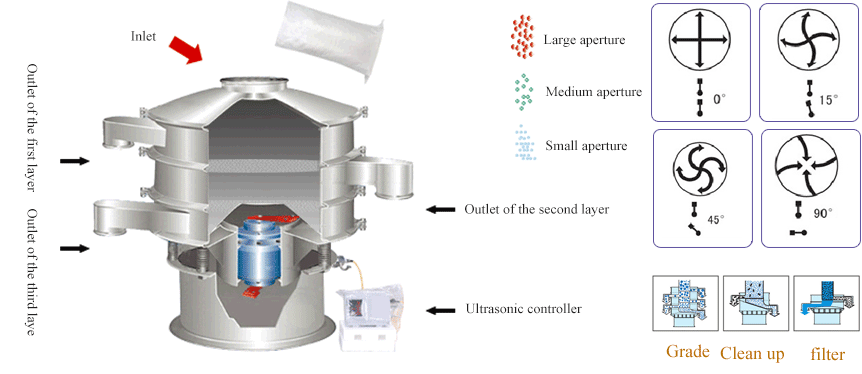In tea manufacturing, precision is key to achieving a product that delights consumers. From the moment the leaves are plucked to the final packaged tea, each stage must be carefully controlled to ensure the highest quality. One of the most important yet often overlooked stages in tea production is the sieving process.
Sieving machines play a crucial role in refining tea leaves, ensuring consistency, purity, and ultimately, a perfect product. This blog will explore how sieving machines are transforming tea manufacturing, making it more efficient, cost-effective, and capable of meeting growing consumer demand for premium, impurity-free tea.
1. Why Sieving is Crucial in Tea Manufacturing
Sieving is a simple but essential process in tea manufacturing. It involves separating tea leaves by size, quality, and purity to ensure that only the finest leaves are packed and shipped. The primary goal of sieving is to remove impurities such as dust, stems, and larger particles that may affect the tea’s taste, aroma, and appearance.
- Uniformity in Size: Sieving ensures that tea leaves are of similar size, which is essential for uniform brewing and consistent flavor extraction.
- Purity: Impurities like dust, twigs, and unwanted particles are removed, leaving behind pure, high-quality tea.
- Consistency: Consistent sieving results in a more consistent product, ensuring that every batch meets the same high standards.

2. Challenges in Traditional Tea Sieving Methods
Before the advent of modern sieving machines, tea manufacturers relied on manual labor to sift through and sort the leaves. However, these traditional methods presented several challenges:
- 1. Labor-Intensive Process
Manual sieving requires significant time and effort, making it difficult to scale production while maintaining consistent quality.
- 2. Inconsistencies
Human error often leads to uneven results, with some impurities slipping through the process and reducing the quality of the final product.
- 3. Scaling Issues
As tea manufacturers grew, maintaining product quality during large-scale production became a challenge. Traditional sieving methods could not keep up with the increased demand without sacrificing quality.
3. The Evolution of Tea Sieving Machines
With the introduction of sieving machines, the tea manufacturing process was transformed. These machines use advanced vibration and mesh technology to automate and refine the sieving process, addressing many of the challenges faced by traditional methods.
Key Features of Advanced Sieving Machines
- Multiple Mesh Layers: Sieving machines are equipped with various mesh layers to sort tea leaves into different sizes, allowing manufacturers to target specific tea grades.
- Adjustable Vibration Settings: These machines can be adjusted for different tea types and desired outcomes, ensuring consistent results every time.
- Dust Collection Systems: Advanced machines come with dust collection mechanisms that minimize contamination and maintain a clean production environment.

Benefits of Sieving Machines in Tea Manufacturing
- 1. Enhanced Product Quality
Sieving machines remove impurities and ensure a uniform size for each tea leaf, which improves the overall quality of the tea. This leads to a more refined, consistent product that meets the high standards demanded by consumers.
- 2. Increased Efficiency
Automated sieving machines process large volumes of tea in a fraction of the time it would take using manual methods. This boosts production efficiency, allowing manufacturers to meet increasing demand without compromising quality.
- 3. Flavor Consistency
By ensuring that each batch is composed of uniformly sized leaves, sieving machines contribute to consistent flavor profiles. Tea with consistent leaf size brews more evenly, leading to a better taste and experience for the consumer.
- 4. Cost Savings
Sieving machines reduce material waste by efficiently separating usable leaves from debris. They also lower labor costs by automating the sieving process, making it more cost-effective in the long run.
- 5. Scalability
As tea manufacturers grow, sieving machines can scale with production, ensuring that quality is maintained even as demand increases. These machines are designed to handle large volumes without sacrificing efficiency or consistency.

Key Features to Look for in a Tea Sieving Machine
When choosing a tea sieving machine for your production line, consider these essential features:
- Capacity: Make sure the machine can handle your production volume while maintaining high quality.
- Adjustable Mesh Sizes: Look for machines with customizable mesh sizes to accommodate different tea grades.
- Automation Capabilities: Choose machines that automate the sieving process to reduce manual intervention and improve consistency.
- Durability: A high-quality machine built with durable materials will provide long-lasting performance and reduce maintenance costs.
- Ease of Maintenance: Look for machines that are easy to clean and maintain, ensuring a smooth operation with minimal downtime.
Case Study: A Tea Manufacturer’s Success Story
One tea manufacturer faced significant challenges with inconsistent product quality due to traditional manual sieving methods. After transitioning to a high-performance sieving machine, they saw remarkable improvements:
- 40% Increase in Production Efficiency: The automated sieving process allowed them to process more tea in less time, significantly boosting production.
- Improved Tea Quality: The consistent leaf size and impurity-free tea led to higher customer satisfaction and an increase in repeat orders.
- Cost Reduction: Labor costs were reduced, and material waste was minimized, resulting in substantial cost savings.
This success story demonstrates how the right sieving machine can enhance both product quality and manufacturing efficiency.
Sieving machines are essential tools in the tea manufacturing process, ensuring that the final product is free from impurities and consistently of high quality. By automating the sieving process, manufacturers can increase production efficiency, maintain flavor consistency, and meet growing consumer demand.
Investing in a high-quality sieving machine is the first step toward achieving perfection in your tea production. With the right equipment, you can optimize your processes, improve product quality, and stay ahead of the competition in an ever-demanding market.
